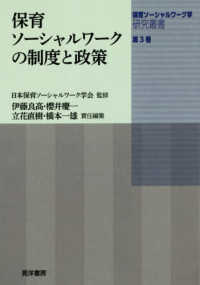- ホーム
- > 洋書
- > 英文書
- > Psychology
Full Description
Psychic phenomena, recorded throughout human history, remained a mystery or a matter of faith rather than a subject of serious study until scientists began to investigate them roughly a century and a half ago. Systematic experimentation began with the work of J.B. Rhine at Duke University, resulting in the publication of Extra-Sensory Perception (1934) followed by Extra-Sensory Perception After Sixty Years (1940). Rhine and researchers who came after him struggled to present sufficient evidence to gain scientific credibility for the existence of extrasensory abilities. Yet despite tight experimental controls and numerous significant results the subject remains controversial.
Parapsychologists argue that the impasse is not due to a lack of evidence but to the challenge their claims pose to the worldview of science in general. This comprehensive overview of the discipline of parapsychology, written by one of its most notable investigators, offers the reader a full understanding of both its concepts, theories and methods, and its controversies, problems and prospects.
Contents
Table of Contents
Preface
1—Background and Beginnings
2—Concepts and Methods
3—Accumulating Evidence
4—Problems of Replication and Application
5—Process-Oriented Research
6—The Problem of Psi-Missing
7—The Experimenter Effect
8—Explanatory Quagmire
9—The Unsettled State: Postscript to Sixty
Years in Parapsychology
References
Index







